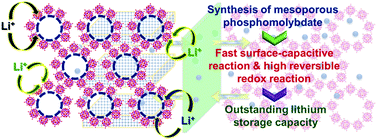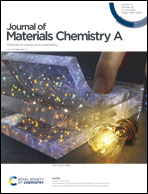Super-reductive mesoporous phosphomolybdate with high crystallinity and its excellent performance for Li-ion battery application†
Abstract
The unique chemical reactivity of polyoxometalates (POMs) makes them available for many applications including catalysis and molecular electronics. However, their use in secondary battery applications is limited due to low specific surface area and moderate electrode performance of POMs. Here, we demonstrate the advantages of super-reductive POMs with defined mesoporous channels for high performing lithium-ion batteries (LIBs). A mesoporous phosphomolybdate (mPMA) with highly crystalline Keggin structure is synthesized via a simple soft-templating approach through the self-assembly of phosphomolybdic acid and non-ionic polymeric surfactant linked by potassium chloride. The mPMA with optimized porous structure shows excellent and stable specific capacities of 1517 and 521 mA h g−1 at current densities of 0.5 and 5 A g−1 respectively. Electrochemical kinetics studies and in situ X-ray absorption spectroscopic analysis demonstrate that the electrode performance of the mPMA is excellent as both faradaic and non-faradaic reactions simultaneously occur in the mPMA, which is available for phosphomolybdate but not for phosphotungstate. To evaluate the potential of mPMA as an anode material for stationary LIBs, a full cell, composed of LiCoO2 and mPMA, is demonstrated.



 Please wait while we load your content...
Please wait while we load your content...